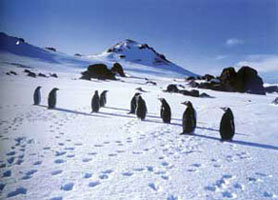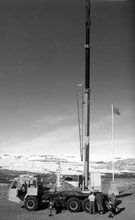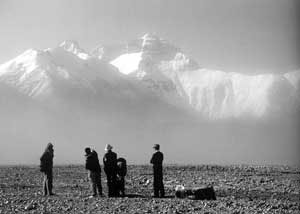考察-Investigate tertiarily
分类: 英语科普
 Artists seek the beauty of nature, while scientists explore its mystery. But faith can have fashions, and more and more people seek life beauty and mystery within the cement forests of urban society.
Artists seek the beauty of nature, while scientists explore its mystery. But faith can have fashions, and more and more people seek life beauty and mystery within the cement forests of urban society. Rebecca Lee still keeps her artistic faith which has sent her trekking to the world’s Grand Trio, the Arctic, the Antarctic and Mount Qomolangma.
The woman artist and explorer from Hong Kong offer both beauty and hardship in her pictures and stories recording these most tantalising domains on our globe.
As a native of Hong Kong, Lee is particularly concerned that the current pattern of industrialisation, urbanisation and motorization might fuel climate change and the destruction of biodiversity on a scale that will lead the world to environmental disaster.
She believes that the world is already in the throes of an environmental disaster of Man’s making.

"After my return from my first trip to the Antarctic in 1985, my soul seemed to be floating on a gust of fresh air, and the call of the polar region echoed incessantly in my heart. Every time I shut my eyes, the pure white icy continent reappeared," Lee said.
"From a distance, the Antarctic continent is a white emptiness, but looked at close up; there is richness and colour in the whiteness. The colour shows hitherto unseen natural and artistic beauty."
Graduating from the former Hong Kong Technical College (now Polytechnic University) in 1964 at the age of 19, Rebecca Lee started off as a graphic designer, but soon became a magazine editor. Since 1970, Lee has taken her backpack and sleeping bag, and travelled to virtually every corner of the globe. She was the first woman explorer from Hong Kong to reach both the South and North Poles. On one of her trips to the Arctic, she planted the Chinese five-star flag at the North Pole.
Between 1992 and 1993, she went on expeditions to Mount Qomolangma in Southwest China’s Qinghai-Tibet Plateau and the Taklamakhan Desert in Northwest China’s Xinjiang Uyghur Autonomous Region.
The pure and clean world of snow and ice at these three extremities of the earth made Lee realise her 23-year experiment was more than worthwhile.
"As an artist, I love the earth, nature, the sky and the sea. As a scientist, I explore nature and study
 the land, floods, storms, as well as the burning of oil in the Gulf. The apparent increase in natural disasters is worrying me. How can future generations survive if our home is polluted?" said Lee.
the land, floods, storms, as well as the burning of oil in the Gulf. The apparent increase in natural disasters is worrying me. How can future generations survive if our home is polluted?" said Lee. Lee calls for people to "always remember that man is born of nature, and that if you try to conquer nature you will be conquered by it. Pollute the environment and you destroy what you have painstakingly built and your own future. The only way to secure nature is to respect and understand your environment."
Touching the "Three Poles"
Since November 1985, Rebecca Lee has participated in China’s Polar expeditions, and has been to the Great Wall Station and Zhongshan Base several times, according to Guo Kun, former director of Chinese Antarctic Administration.
"Every time she returned from a trip, she wrote books, held photo exhibitions and gave lectures on Antarctica, talking about the selfless contributions of Chinese scientists in exploring the great white world," Guo said.
"Rebecca has travelled to every corner of the world. It is her courage and perseverance in carrying out her undertakings that I admire the most, and without a doubt, she is a remarkable Chinese woman."
Lee joined China’s seventh Antarctic expedition, which lasted from December 1990 to March 1991.
She experienced the turbulent seas of the southern oceans on board the "Jidi," which served as China’s scientific exploration vessel from 1985 to 94, the floating ice and glaciers in the Antarctic Sea, the majestic white sheets of ice, and also joined in the struggles of exploration team members against the storms.
All these experiences generated an intriguing idea in the back of her mind: That "Polar Power" (or the "White Force," as most of these places are covered with ice and snow), not only works its will on artists but also on scientists.
"I remember that dreadful day when the wind was blowing terribly hard and snow falling forcefully, Rebecca came running to me and exclaimed:訧have at last realised the Polar Power.’ I was astonished by her new concept," said Liu Xiaohan, a researcher from the Institute of Geology of the Chinese Academy of Sciences.
"I dare to say that perhaps all scientists on earth who have had anything to do with the Poles have long felt the existence of the white force in their hearts, but it is Rebecca, an artist, who has identified it," Liu added.
Although the Grand Trio are like mute giants hidden at the ends of the earth, any changes there could strike the central nerve of the earth. It is not an exaggeration to say that the White Power is mightier than the green power, and the human world may well face harsh punishment for having offended it.
"The world is made up of white and green structures. Compared with the green world, the Antarctic white world is harsh, forbidding and solitary," Lee said.
Modern scientists have, nevertheless, proven that this remote white world continues unceasingly to affect the entire global weather system. This white world controls the future of human beings.
"Antarctic scientists are not only trying to unveil the true nature of this forbidding expanse of icy desolation, but also to promote the will to protect this last major wilderness from human disturbance and exploitation," Lee said.
Nature, humanity and art
Lee prefers to be called an artist, although she has several other titles ?writer, photographer, film director, magazine editor, art director, world traveller and polar explorer.
"When I was young, I studied the fine arts. Armed with the things I learned from my family and my teachers, I began my journey to become an artist. I painted pictures, created designs, shot films, took photographs, published magazines, and did what fine artists would do.
"I am often called an explorer, photographer and traveller. In fact I am no more than an explorer looking into the art of life."
"At the ’Three Poles,’ I have found the true value of life; more importantly, I have found the true value of life in art."
"The artist should not only paint what he sees before him, but also what he sees within him," Lee said.
At her "Three Poles," Lee experienced the "integration of nature and humanity." At the same time, living in the context of the Poles, she found that the Creator is art.
"The Creator is the greatest artist. She changes the colours of the sky and the earth, as well as those of the climate, ranging from the nuances of the rainbow to greys and darkness. She then allows us to look for her, care about her and breathe with her."
"When I understand the value of life, the ’Three Poles’ will give me the content of art. The experience of life, senility, illness and death, although miserable and disgusting for some people, doesn’t mean much to me after my baptism at the ’Three Poles,’" Lee said.
"What is meaningful to me is the close relationship between the life, senility, illness and death of humanity and nature. Destruction of nature will bring ill fortune to our life. Caring about nature will enable us to create a thriving life for art and provide us with rich sources for art."
Rebecca Lee has captured the scenes along her journeys in the thousands of photographs she has taken and presented at exhibitions in Hong Kong, the Chinese mainland, the United States, Canada, England and Singapore.
Lee has contributed significantly to polar exploration, offering her art in the service of science. In recent years, she has devoted her considerable energies to the global environmental movement, as well as to fund-raising for the China Polar Museum Foundation, which she established in 1997.
"Is it worth spending 23 years on promoting Polar science to the public?" she often asks herself.
Her reply is firm ?my work is a gift, a gift from heaven, although there is always a price to pay for one’s life.